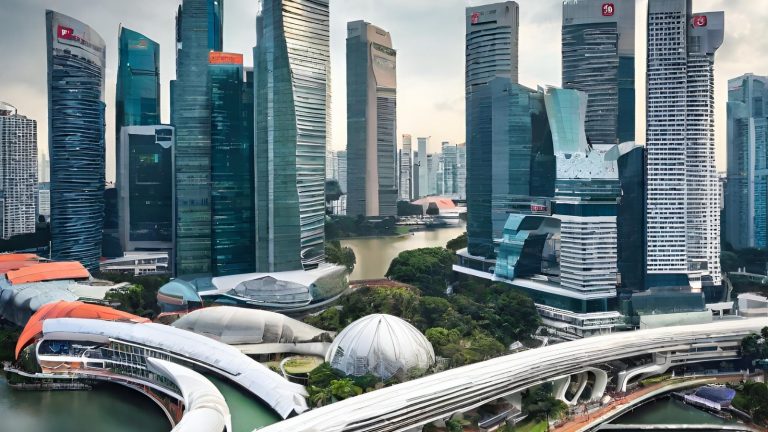Singapore may not have a history flying back a long way, but it has definitely marked its existence on the world map with outstanding development and enthusiasm for new things. This is exactly how this country moves forward with major steps as a nation. When it comes to Singapore, there is no area that has not been developed throughout these years. However, with such a drastic improvement, Singapore’s main target is to become a ‘Smart Nation’ by 2025.
What is this Smart Nation plan for Singapore? What are they planning to do, and what purposes lie behind these initiatives? Come, let’s find out everything in this article.
We will understand
What is Singapore's Smart Nation Concept?

- There are some major public conversations happening around the topic of Singapore being a smart nation by 2025.
- Singapore recently unveiled its smart nation project in response to an economy that is becoming more and more digital and knowledge-based.
- If we fly back to the stem of this, Singapore’s transition into a smart city was initially proposed and finally put into action in the shape of the Smart Nation programme at the confluence of the two main issues. One is its increasing urban complexity, and the other is obviously economic digitisation.
- The smart nation effort was more than just a way for Singapore to mobilise and apply cutting-edge digital and info-communications technology (ICT) to complicated urban challenges. On the other hand, it also served as a way to explore possible new development opportunities related to the emerging digital economy.
- Also, understanding the importance of covering each area of the country, modifications to Singapore’s public administration philosophy were brought about by the Smart Nation project.
- However, although Singapore talks about the smart nation plan publicly now, the basic attempts at this were made a long time ago. The first initiative started in the 1980s, according to reports from the Civil Service computerisation programme. Then, in 1992, the government launched an IT 2000 strategic plan focusing on the challenges of the new millennium.
- In 2000, they initiated e-government action plans 1 and 2, followed by the iGov 2010 plan. For this smart nation concept, the year 2014 is quite memorable, as it was the time the Singapore government officially started its efforts focusing on smart nations. This was backed up by the eGov Masterplan project in 2011. There was a project named ‘Digital Government Blueprint’ in 2018 as well. These were the actual benchmarks of the Smart Nation concept in Singapore.
- If we look into the mid-layers of the concept, we can see that the Singaporean authorities have initiated the goals, dividing them into three key pillars. These are the digital economy, digital government, and digital society.
- As officially launched in 2014, the primary aim of the Smart Nation initiative was to support better living, stronger communities, and create more opportunities for all’.
- Improving people’s lives and generating new economic possibilities are the two main components of this.
- The Singaporean government has always been emphasising the importance of improving its citizens’ lives, enhancing economic productivity, and exploring new prospects through the use of such technology, along with pushing them to communicate with each other through the use of sensors and sophisticated devices.
Understanding Singapore's Strategy to Become a Smart Nation in 2025

Undertaking Digital Transformation
Achieving Singapore’s Smart Nation plan requires a comprehensive strategy for undertaking digital transformation across all sectors.
This means integrating advanced technologies like artificial intelligence, the Internet of Things, and data analytics into existing infrastructure and processes.
Embracing digital transformation encourages seamless connectivity, enhances efficiency, and establishes the environment for innovation in areas such as transportation, healthcare, governance, and energy management.
So, what do they expect from this? As you can see, when promoting a culture of digital innovation and investing in the necessary infrastructure and capabilities, Singapore can extract the full potential of technology to create a sustainable, resilient, and inclusive Smart Nation by 2025.
They believe that it will enhance the quality of life for its citizens and drive economic growth in the digital age.
Gathering Intensive Workforce
Even though a government has an outstanding plan to establish a digitalised society, the country needs to have a skilled workforce. This has been quite challenging for Singapore. Though they have so many vacancies in the IT sector, at least half of this portion cannot be filled by Singaporeans.
On the other hand, to achieve Singapore’s smart nation plan, it is highly vital to gather an intensive IT workforce through strategic initiatives.
This involves investing in education and training programmes to develop a skilled talent pool proficient in cutting-edge technologies such as data analytics, cybersecurity, and software development.
If they can attract and retain top IT talent, Singapore can drive innovation, spearhead digital transformation efforts, and sustain its competitive edge in the global digital economy.
This is why they have started fostering collaboration between academia, industry, and government entities to facilitate knowledge sharing, skill development, and the co-creation of innovative solutions to address complex challenges facing the nation. Also, they heavily depend on global talents when it comes to the IT sector.
It is quite visible that a robust IT workforce forms the backbone of Singapore’s Smart Nation aspirations. Since the relevant authorities have foreseen this, they have taken the necessary actions to ensure the successful implementation and continuous advancement of digital initiatives across various sectors.
Investing in Smart Technologies
Singapore’s smart nation plan also includes strategic investment in smart technologies across diverse sectors such as transportation, governance, healthcare, and energy.
They plan to accomplish this by deploying advanced technologies like IoT, AI, data analytics, etc. If this is achieved, Singapore can enhance efficiency, connectivity, and sustainability in transportation systems, optimising traffic flow and reducing congestion.
Comparably, putting digital governance technologies into practice raises citizen participation, encourages openness, and improves public service delivery.
Smart technology integration in industries like healthcare also makes it possible to provide individualised care, effective resource allocation, and remote monitoring. It means a few steps ahead of time!
This is the main reason the government targets investments in smart technologies in the first place.
Singapore has the capacity to establish a unified digital environment that raises living standards, boosts economic expansion, and establishes the country as a leader in innovation and technology uptake worldwide.
Expanding 5G Technology
Now let us explain how Singapore’s smart nation plan can be drastically advanced by strategically expanding 5G technology. This means putting up a large portion of the network’s structure to guarantee high-speed connectivity and vast coverage, which will provide smooth communication and data sharing between different industries.
With its low latency and high bandwidth capabilities, 5G technology forms the backbone of innovative applications such as autonomous vehicles, smart grids, and remote healthcare services.
Singapore can take advantage of 5G’s revolutionary potential to accelerate digital innovation, boost productivity, and improve the quality of life for its people by promoting collaboration between government agencies, telecommunications providers, and industry players.
To further cement Singapore’s position as a global leader in the digital economy, the country is investing in R&D projects to investigate innovative use cases and applications of 5G technology.
Digital Literacy and Inclusion Programmes
If you want to become smart and resilient in the evolving landscape, you need to have a good understanding and knowledge of what is happening. This is what we call ‘education’.
Singapore has understood that prioritising education and training initiatives is the first step to empowering citizens of all ages and backgrounds with the necessary digital skills to fully participate in the digital economy and society.
These programmes aim to bridge the digital divide by providing equitable access to technology and digital resources.
On one hand, promoting digital literacy in the workforce ensures that individuals can adapt to evolving technological landscapes. This will eventually enhance employability and productivity. On the other hand, promoting inclusivity in digital initiatives ensures that marginalised communities and vulnerable populations are not left behind. It promotes fair access to opportunities and a sense of community.
Singapore could promote a digitally literate and inclusive society, boosting sustainable growth and development in the Smart Nation age, if they allocate resources towards digital literacy and inclusion programmes.
Sustainable Energy Management
What development is possible without showing gratitude to the environment?
Singapore has identified that it needs to build a bridge connecting sustainability and development. This involves investing in renewable energy sources such as solar and wind power, coupled with smart grid technologies to optimise energy distribution and consumption.
Implementing energy-efficient solutions in buildings, transportation, and industries further reduces carbon emissions and enhances energy resilience.
Plus, promoting energy conservation through public awareness campaigns and incentivising sustainable practices creates a culture of environmental protection. Singapore’s energy infrastructure will remain resilient and viable over the long run by working together with stakeholders to create laws and policies that promote sustainable energy practices.
Laying an Unshaken Foundation to Become the Smartest Nation by 2025

Although Singapore has an outstanding roadmap, it will not be easy to implement all these efforts. If they have robust tools and technologies to back up their initiatives, they will receive some sort of helping hand to become the smartest nation by 2025.






